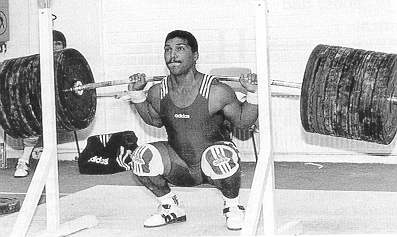As promised here is the second part of the First Pull interview. If you missed part 1 click HERE. Let’s jump into then:
Fusion Weightlifting: How do you approach squats, is your focus on a high frequency of front squat vs. back squats, or do you take a more balanced approach?
Jean-Patrick: “Squats are probably the most important assistance exercise for weightlifting, all things considered. I program front squats and back squats. I will prioritize the front squat over the back squat if the athlete is not reaching a certain percentage of their back squat (85-90%).
Generally speaking and this may change for certain lifters; I think beginners don’t need the frequency (say 1-2 times a week). Intermediate lifters need some kind of frequency (say 3-4 times a week) and high level lifters probably need the same or more (3-6 times a week). That’s a rule of thumb. These things really depend on the individual, on weaknesses, training phase and on what you are getting done every time you squat.
Sometimes you don’t need to squat as frequently depending on your program and where you are at as a lifter. Trainability is another thing to consider. Some people can grow a massive squat by squatting 2-3 times a week to failure and some people actually need to spend a lot of time doing sets and reps at 80%.
http://youtu.be/VcEsmhVag1c
As a side note, I know of elite lifters who front squats 8-11 times a week but that should not be an indicative to do the same. People forget too quickly that elite lifters have years of experience and troubleshooting under their belt so they can deal with the high volume/intensity. Elite lifters also tend to have good training and life conditions as well. Finally, except for exceptions, that kind of training is usually programmed in blocks. So it comes and it goes, so does the volume and intensity.
One program that works well that I have used with athletes is to go for a daily 1 or 2 or 3 or 5 rep(s) max (daily max does not mean all time best). The squats have to be done without a massive grind, but it has to be quite hard. Then you back off 10-15% for 3 sets of 2-5 reps (basically back off to do the same number of rep, or add 1 rep. If you were doubling doubles, you are now doing triples). It’s easy to program, does not take long and does not tire the lifter as much as other programs.”
http://youtu.be/aelWxpTZD0s
Fusion Weightlifting: What are your thoughts on overhead squats for carry over to snatches with novice-intermediate weightlifters?
Jean-Patrick: “The carry over are indirect in this case.
That being said, the overhead squat is a fantastic tool that I use for mostly 2 reasons. The first one is to develop proper mobility of the shoulder, back, hips and legs. The second reason has to do with an athlete bottom position being unstable.
Thus, better mobility and a more stable bottom position lead to bigger numbers.
However, an intermediate lifter should already be mobile and stable so its carry over are not as big. Still a good tool to add in complex on lighter days to ‘’bodybuild’’ with intermediate lifters.”
Read more about Jean-Patricks thoughts on overhead squats HERE.
Fusion Weightlifting: What are your thoughts on daily max lifting for beginning weightlifters and international lifters?
Jean-Patrick: “For beginners, I would disagree with it. You have to leave them the time to get used to the lifts, deal with their lifestyle so that recovery is not much of a problem, and let the mobility and strength develop. Upon starting, especially in North America where people start in their twenties, most beginners will have aches in the hip or shoulders that will go away after a few weeks. This is a good sign that the structures are not ready to take a beating. Just because you are not maxing out does not mean you are not getting work done.
International lifters are something else. In my experiences and correspondences, all I can say is that some do it and some don’t do it. Again, it is a matter of adapting the training system to the athlete. Some do well on high intensity plans and some needs variations in training intensity.
Fusion Weightlifting: Weightlifting is growing very rapidly in the US and our talent is significantly developing, particularly our young weightlifters at the OTC, MD-USA, Columbus weightlifting and many others clubs. What is the Olympic weightlifting culture like in Canada?
Jean-Patrick: “I am very impressed by the recent US efforts and would like to congratulate every athletes and coaches that have been working hard. I am especially impressed by the Barnes brothers, Osorio, Wilson, and lifters like Jenny Arthur. Bravo!
We have a long standing tradition in weightlifting here. Currently, our best QC lifters are probably Pascal Plamondon, Marie-Eve Beauchemin Nadeau, George Kobaladze, Mathieu Marineau, Francis Luna Grenier, Krystel Ngarlem, Marie Julie Malboeuf and more. Many of them have a great future in front of them.
In Quebec, our problem was never getting people good. The whole thing is run on passion and the love of the sport is shared by athletes and coaches. Our problem is failing to provide the right winning conditions to potential lifters, losing the national center in the 80’s and never making an effort to chase it back, not representing and defending the clubs that are getting kicked out of schools, failing to recruit people due to very poor media usage, not putting into place a plan for recruiting, failing to provide informative seminars so that athletes and coaches improve their knowledge about different topics, not including crossfitters (this worked well for the US, money wise), and not recognizing and promoting the exploit of our master lifters who are amongst the best in the world. Hopefully this will change over time. Our athletes and coaches have a lot to offer.
There was a time where we could have said that weightlifting in Canada was mostly booming due to the province of Quebec. This is not as true anymore. Big efforts are being made in Ontario and they are coming up nicely. Their junior squad beat our junior squad this year – a first in 15 years. I believe they will have a lot of people medaling at the nationals too. Great efforts are also made by British Colombia. This is exciting.
As a side note, we have a great competition calendar and I would like to thank all officials and competition runners. They are doing a great job!”
Fusion Weightlifting: I know this is a loaded question with many variables that come into play, but generally speaking how do you peak your weightlifters for competition? What is important to consider in the 5 weeks prior to the competition?
Jean-Patrick: “It is indeed a very loaded question and one that is hard to answer due to the principle of individualization. Some people can show up at competition without much tapering and some have to start tapering 3 weeks before the competition. That being said, I will try my best to sum up what’s conventional and what I personally like.
This is very general and should be adapted to meet the individual needs. Let’s say our lifter is an intermediate lifter (Thus not elite). He has a job and little competition experience. He usually trains 4 times a week, so we will aim that session 4 is competition day.
If you have 5 weeks, then you know you have 4 weeks of training and 1 week of ‘’true’’ tapering. Many people switch into ‘’Bulgarian mode’’ a month before the tapering week. In other words, the volume is getting cut drastically every week, but the intensity is quite high all along. The focus is on competition lifts and some squats. It’s not rare to see 85-95% training sessions. Recovery days can be relatively moderate-heavy powers. From week 4 to 1 week, the amount of sets and reps get cut down each week but the intensity has to remain high.
Week 5, or the tapering week, is where training has to help get rid of the accumulated fatigue. First session of the week, you will go for openers (1-2 sets of 1) and some squats (a few heavy singles). You don’t need to go for a max the week before the competition, but you are encouraged to do so quite often in the 4 weeks prior to that (say 1-2 times a week, and 1-2 85% sessions, or something like that). Again, missed reps should be limited because it can break the athlete psyche going into the competition.
Second session is usually around 75-80% for most people (1-3 sets of 1 rep) and some medium squats (say as heavy as your clean and jerk of the day). Third session is mostly recovery oriented and all about getting warmed up. People go up to 70% (sometimes less). You may do powers on that day as well.
Competition is usually the next day or the day after a rest day. I understand that people have different ways of tapering. Some will max out the day before competition. Beginners and intermediate lifters should not worry about that. To paraphrase Tommy Kono, it’s better to go to the competition with hunger and feeling too rested than to go to the competition over trained. Again this is very general and the coach has to know his/her athlete so that this 5 weeks are well adapted to type of lifter the athlete really is. Also, the better the athlete (in terms of weight lifted) the higher is the need for tapering. Most beginners don’t even need to taper that much.”
Fusion Weightlifting: Is there anything else you’d like to touch base?”
Jean-Patrick: “Thank you very much for this opportunity. I would also like to thank every readers and everybody that have shared/printed my articles to distribute. I hope I could answer the question to your satisfaction and don’t hesitate to contact me if you have more questions. I wish everybody success in this amazing sport.”
You can find out more information and support First Pull via:
Stay Strong,
Team Fusion Weightlifting





